Listen to the Podcast
15 Mar 2024 - Podcast #873 - (19:53)
It's Like NPR on the Web
If you find the information TechByter Worldwide provides useful or interesting, please consider a contribution.

If you find the information TechByter Worldwide provides useful or interesting, please consider a contribution.
It’s easy to get suckered into signing up for a service that has monthly charges. Fifty bucks here, fifty bucks there. Your bank account is depleted and you’re not quite sure what happened. I encountered one of these fraudulent “services” recently but dodged the bullet.
Click any small image for a full-size view. To dismiss the larger image, press ESC or tap outside the image.
 I can’t say with absolute certainty that I never signed up for the fruust.com five-day trial, but I don’t recall signing up for it and the service offers things that don’t really interest me. “Explore Movies, Games, Music & More - All in One Place: Movies, Music, Audiobooks, Games, Software, Sports, and Concerts. Pick and play whatever you want!” I subscribe to the streaming services that have the programs I want. Movies, music, and audiobooks are provided by the library. I license the software I need; I’m not interested in sports; and an online service can’t really provide access to concerts.
I can’t say with absolute certainty that I never signed up for the fruust.com five-day trial, but I don’t recall signing up for it and the service offers things that don’t really interest me. “Explore Movies, Games, Music & More - All in One Place: Movies, Music, Audiobooks, Games, Software, Sports, and Concerts. Pick and play whatever you want!” I subscribe to the streaming services that have the programs I want. Movies, music, and audiobooks are provided by the library. I license the software I need; I’m not interested in sports; and an online service can’t really provide access to concerts.
So I’m fairly sure that I never signed up for the $50/month service. Not even the five-day free trial.
But a $50 charge was attempted to my Chase Visa card. Chase sent a message asking me to “Confirm you made this purchase.” The charge had been made via 2MEGAGAT.CO, which I didn’t recognize. So I opened a chat session with the billing organization and asked about the charge, which had already been declined by the bank. No harm, no foul, right?
No, the “no harm” part can be put down mainly to Chase Bank’s vigilance. Had the charge been successful, it seems that I would have had a lot of trouble cancelling the service. I found a lot of complaints by people who had accidentally subscribed and couldn’t seem to unsubscribe. So I looked a bit further.
Every scam-watcher website I checked had bad news about Fruust. Every single one. IsLegitChecker says: One of the most alarming aspects of Fruust.com is its involvement in a subscription scam. Users have reported difficulties in canceling their subscriptions, trapping them in recurring charges against their will. Despite promises of free movie access, Fruust.com creates a web of complexity, making it virtually impossible for users to sever their ties and escape the recurring charges unscathed.
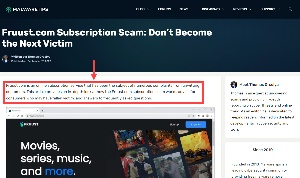 MalwareTips says Fruust purchases ads deceptively blended into search results for popular apps. The ads appear alongside legitimate promotions, tricking users into clicking through to hidden Fruust subscription sign-ups, where they are prompted to enter an email address and credit card information to begin the 5-day free trial. The submission page makes no clear mention of recurring charges. [Note the Fruust website has added, in small but legible type, “5 days free, then starting from $ 49.95 per month.” The words “starting from” make me nervous, suggesting that the actual price could be considerably higher.]
MalwareTips says Fruust purchases ads deceptively blended into search results for popular apps. The ads appear alongside legitimate promotions, tricking users into clicking through to hidden Fruust subscription sign-ups, where they are prompted to enter an email address and credit card information to begin the 5-day free trial. The submission page makes no clear mention of recurring charges. [Note the Fruust website has added, in small but legible type, “5 days free, then starting from $ 49.95 per month.” The words “starting from” make me nervous, suggesting that the actual price could be considerably higher.]
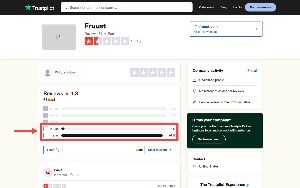 TrustPilot offers reviews from actual users. Although the service has only 64 reviews, 63 of them are one-star reviews and and 64th review gives just two stars. One reviewer on Reddit described my experience: “I never even signed up for anything and was charged $49.95. I don’t even know w[h]at Fruust is.” I know that when I give any organization a credit card number for a free-trial offer, I make a note about when the free trial will end. It’s unclear how Fruust obtained my credit card number, but it no longer matters because I reported the scam to the bank and received a replacement card with a new number.
TrustPilot offers reviews from actual users. Although the service has only 64 reviews, 63 of them are one-star reviews and and 64th review gives just two stars. One reviewer on Reddit described my experience: “I never even signed up for anything and was charged $49.95. I don’t even know w[h]at Fruust is.” I know that when I give any organization a credit card number for a free-trial offer, I make a note about when the free trial will end. It’s unclear how Fruust obtained my credit card number, but it no longer matters because I reported the scam to the bank and received a replacement card with a new number.
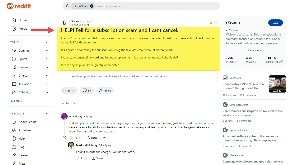 And I found similar accounts on Reddit.
And I found similar accounts on Reddit.
Had I thought about signing up for the service, I would first have checked the company out with a search containing the name of the company and the word “fraud”. Whether you use Google or DuckDuckGo to perform such a search, the results would be immediately clear that Fruust.com is a company to avoid. It’s easy to check companies out to avoid becoming entangled in most scams. The only exceptions are when the scammer somehow gets its hands on a valid credit card number and uses it.
And had I actually signed up for the service, I would have added log-in information in my password manager. There was no entry for Fruust.com. So I have to agree with with the reviews that say the site isn’t exactly an honest business.
Google makes a lot of what they call “fonts” available for anyone to use. How many? Google claimed 1601 fonts when I prepared this report, but Google actually offers at least 1601 billion fonts. More accurately, it’s an infinite number of fonts.
That’s because a font probably isn’t what you think it is. We can thank Steve Jobs, among others, for the confusion. I’ll come back to that in a bit.
If you’re old enough, you may remember that computers didn’t have typeface options in the beginning. Line printers that were used on mainframe computers didn’t even offer lowercase letters. Then dot matrix printers came along, and they could create different types of letterforms. The earliest $3500 laser printer didn’t even offer more than just Courier unless you laid out several hundred dollars for a cartridge that offered a few options. Then Adobe happened and nothing has ever been the same.
Click any small image for a full-size view. To dismiss the larger image, press ESC or tap outside the image.
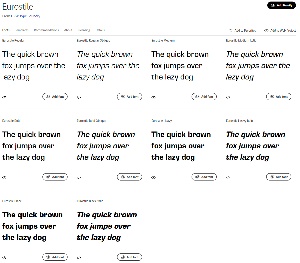 So why are what you may think of as “fonts” really not fonts? When Apple made multiple typefaces an option for Mac users, Steve Jobs decided to call them fonts. Designers, publishers, and typographers fought against it for a while, but that was 40 years ago. It’s just one of those distinctions that got lost along the way. What most people think of as a font is really a typeface. Eurostile is a typeface and you can view it on Adobe Fonts (although you may need a subscription to do so).
So why are what you may think of as “fonts” really not fonts? When Apple made multiple typefaces an option for Mac users, Steve Jobs decided to call them fonts. Designers, publishers, and typographers fought against it for a while, but that was 40 years ago. It’s just one of those distinctions that got lost along the way. What most people think of as a font is really a typeface. Eurostile is a typeface and you can view it on Adobe Fonts (although you may need a subscription to do so).
Eurostile Regular 12-point is one font. Eurostile Regular 14-point is another. And Eurostile Bold Oblique 12-point is yet a third. A font includes additional information about the presentation of the typeface such as size, weight, width, and italics. Maybe one reason that the distinction has blurred is the ability to resize type on the fly using a computer. In hot-metal type times, the printer would need three sets of type for the three Eurostile faces I mentioned. Now you need install only the various Eurostile variants and you can resize them as needed. If you’d like a more detailed and entertaining look at typefaces, see Cam Walker’s half hour YouTube program.
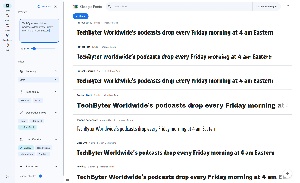 Google Fonts has typefaces in 27 languages. If you’re looking for letters used in English and other Western languages, be sure to select either Latin or Latin Extended. Then you can choose special typeface technologies if you wish (variable or color), decorative stroke (serif, sans serif, or slab serif), classification (display, handwriting, monospace, or Noto symbols), and limit the number of typefaces shown to only those with multiple variants.
Google Fonts has typefaces in 27 languages. If you’re looking for letters used in English and other Western languages, be sure to select either Latin or Latin Extended. Then you can choose special typeface technologies if you wish (variable or color), decorative stroke (serif, sans serif, or slab serif), classification (display, handwriting, monospace, or Noto symbols), and limit the number of typefaces shown to only those with multiple variants.
Next question: If you have a choice of 1600 typefaces and an infinite number of fonts, what’s the best one for your document? That’s a question with an easy answer. Two, actually. Diametrically opposed and both accurate. Answer number one: There is no best font. Answer number two: Any font can be the best one. Perhaps you’ve heard of Comic Sans. It’s a typeface that snobs love to hate, but there are times when it’s exactly the right face to use. Vincent Connare invented Comic Sans in 1994 because he was looking for something that was light and fun. Comic Sans is exactly that. So Comic Sans would be exactly the wrong typeface for an annual report by a large corporation unless perhaps that corporation produces comic books (or in today’s terminology, graphic novels).
As Vincent Connare said about his Comic Sans typeface, “If you love it, you don’t know much about typography. If you hate it, you really don’t know much about typography either.” The same can be said about any typeface. Love it if it’s right for the job; hate it if it’s not.
 There’s no shortage of hate for Souvenir, for Times New Roman, and for Papyrus, but each of those typefaces and every other typeface has an appropriate use. I had the good fortune to spend some time learning from Jan White. Over his 40-plus years as a designer and typographer, he wrote twelve books on grids, page layout, typography, designing charts and graphs, the use of color, and other aspects of information design. I have several of them at home. White’s guiding principle was that good typography is invisible. If someone comments on the typeface you’ve used, the project has failed.
There’s no shortage of hate for Souvenir, for Times New Roman, and for Papyrus, but each of those typefaces and every other typeface has an appropriate use. I had the good fortune to spend some time learning from Jan White. Over his 40-plus years as a designer and typographer, he wrote twelve books on grids, page layout, typography, designing charts and graphs, the use of color, and other aspects of information design. I have several of them at home. White’s guiding principle was that good typography is invisible. If someone comments on the typeface you’ve used, the project has failed.
White arranged to have several of his books released as PDF documents in the public domain following his death a decade ago. Design professionals may already have these books, but not everyone who must work with type and design is a professional. White’s books can help anyone create documents and publications that may not win design prizes, but also will not be ugly or unreadable. For more information see the Jan White memorial website.
Typography, typefaces, and fonts can be a lot of fun, even if you don’t know what you’re doing.
Do you trust Amazon ratings and reviews? To borrow a few words from Star Trek’s Mister Spock, “That would be illogical.” Some of the reviews are accurate, but even when you’ve eliminated the fake reviews, they may not be helpful.
Let’s start with getting rid of the fake reviews. ReviewMeta uses AI to examine reviews of a product you may be interested in buying and attempts to remove the fakes. But ReviewMeta admits that its analysis may be flawed. Before using the site, you have to agree to these terms, as well as the site’s longer terms of service and privacy policy: “ReviewMeta is a metrics tool for evaluating Amazon reviews. We are in no way affiliated with or responsible for any products bought on Amazon. We only provide an analysis of user reviews. Our estimate is based on deep data analysis. PASS/FAIL/WARN does not necessarily prove the presence or absence of ‘fake’ reviews.”
Let’s say you’re interested in buying an Amazon Kindle Fire 11 tablet with 256GB of memory and no ads on the lock screen. There are 3450 ratings with an average rating of 4.4. ReviewMeta eliminates 1207 reviews as being unreliable but the resulting average rating is still 4.4. The system considers whether reviewers are verified purchasers of the item, whether the reviewer has a history of having their reviews deleted, whether reviews have been paid for or otherwise influenced by the provider, and more.
Click any small image for a full-size view. To dismiss the larger image, press ESC or tap outside the image.
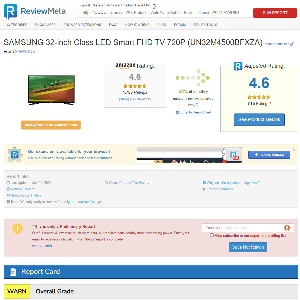 If you search for a Samsung 32-inch Class LED Smart FHD TV [720P (UN32M4500BFXZA)], you’ll find 1788 reviews, but ReviewMeta considers nearly 1100 if them to be suspicious. The result of removing those reviews doesn’t change the overall rating, though. So this may be a useful tool to use when shopping on Amazon, but it still doesn’t resolve overarching concerns about Amazon reviews in general.
If you search for a Samsung 32-inch Class LED Smart FHD TV [720P (UN32M4500BFXZA)], you’ll find 1788 reviews, but ReviewMeta considers nearly 1100 if them to be suspicious. The result of removing those reviews doesn’t change the overall rating, though. So this may be a useful tool to use when shopping on Amazon, but it still doesn’t resolve overarching concerns about Amazon reviews in general.
Amazon reviews can be a valuable resource, and I generally look at them when I’m considering a purchase. The reviews serve as a single data point, but they are insufficient in helping to guide intelligent buying decisions. It’s reasonably well known that Amazon’s product pages often have many deceptive reviews because unethical companies can manipulate ratings easily. They may offer discounts for positive reviews or even payments to reviewers. After all, more positive reviews means the product will be more visible on Amazon.
Seeing “Verified Purchase” on a review means Amazon believes the reviewer has bought the product, but some companies anonymously send free products to random individuals hoping to get positive reviews. This doesn’t work for high-cost or low-margin products, but it has proven effective for fraudulent products that are acquired at a low cost and sold at a huge profit.
Fake reviews seem to be all too common. An article in the Chicago Tribune claims its research shows 42% of reviews it examined were bogus.
Amazon does investigate suspicious reviews, but the volume of reviews makes it all but impossible to catch more than the worse offenders. Tom’s Guide says Amazon encourages customers to report suspicious reviews and that the company will suspend, ban, or even pursue legal action against bad actors.
In “Buyer Beware: Amazon’s Questionable Product Ratings”, a long and technically complex article by the New York City Data Science Academy, writer Will Freeman says Amazon ratings cannot be trusted, but he notes that it’s difficult to develop a definitive policy: A more specific question is whether Amazon reviews reliably and accurately differentiate better products from worse products. Obviously, there is no available “correct” average rating for each product. But there are more reliable and objective sources of product reviews. There is also the question of consistency: if reviews are inconsistent across a large set of reviewers, over time or from one e-commerce platform to the next, that would suggest they are not sensible or trustworthy.
So when you’re thinking about making a purchase, check more than just Amazon. Ask your preferred search engine to provide reviews. See what an organization such as Consumer Reports has to say about the product or the manufacturer. Check with the Better Business Bureau and find out if there are active complaints.
“Let the buyer beware” has never been more important than it is today. Or as they said in Caesar’s day, “caveat emptor.”